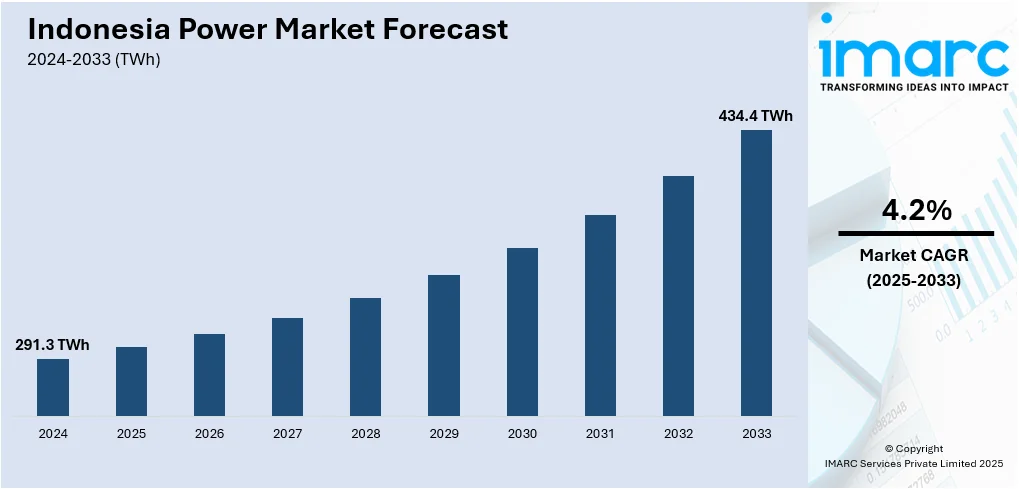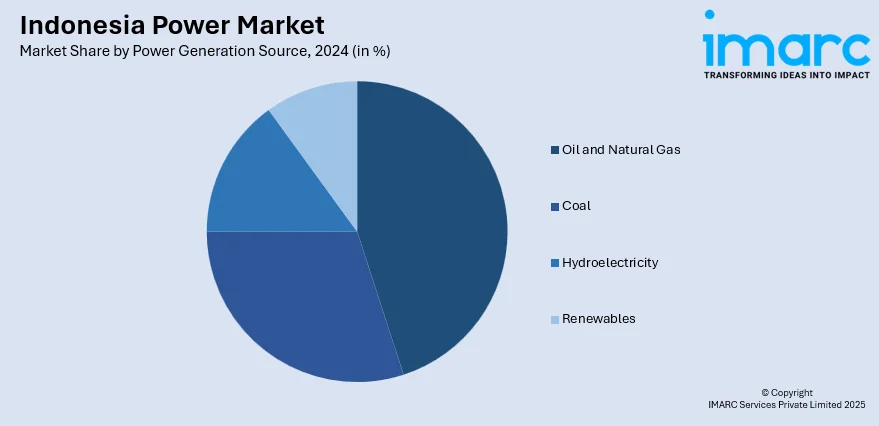
Indonesia Power Market Size, Share, Trends and Forecast by Power Generation Source, and Region, 2025-2033
Market Overview:
Indonesia power market size reached 291.3 TWh in 2024. Looking forward, IMARC Group expects the market to reach 434.4 TWh by 2033, exhibiting a growth rate (CAGR) of 4.2% during 2025-2033. Rapid urbanization and industrialization, the widespread adoption of renewable energy, expanding digitalization across the power sector, the modernization of existing aging infrastructure and increasing initiatives regarding electrification, and growing income levels of individuals represent some of the key factors driving the market.
|
Report Attribute
|
Key Statistics
|
|---|---|
|
Base Year
|
2024 |
|
Forecast Years
|
2025-2033
|
|
Historical Years
|
2019-2024
|
| Market Size in 2024 | 291.3 TWh |
| Market Forecast in 2033 | 434.4 TWh |
| Market Growth Rate (2025-2033) | 4.2% |
Power refers to the rate at which energy is generated, transferred, or consumed over a specific period. It is a fundamental metric that quantifies the speed or intensity at which energy is converted from one form to another or how quickly it is used to perform work. Power is typically measured in watts (W), which are equivalent to joules per second (J/s). In the field of energy, power plays a pivotal role in understanding the efficiency and capacity of various energy systems, such as power plants, engines, and electrical devices. Power generation measures how much electrical energy a generator can produce per unit of time, reflecting its ability to meet the demands of consumers. Power transmission lines are designed to carry electrical power from generators to end-users, and the power rating of electronic devices or appliances informs us of their energy consumption rate. It plays a crucial role in driving economic expansion and improving overall well-being, serving various sectors, such as manufacturing, healthcare, transportation, and digital services, rendering itself as indispensable in modern society.

To get more information on this market, Request Sample
Indonesia Power Market Trends:
The Indonesia power market is experiencing robust growth driven by the nation's commitment to achieving energy security, economic development, and sustainability. Besides this, rapid urbanization and industrialization are leading to a surge in power requirements, creating a favorable outlook for market expansion. Moreover, the government's initiatives to diversify its energy mix prompted by global climate change concerns and the country's abundant renewable resources, emphasizing renewable sources like solar, wind, and hydro, thereby reducing the dependence on fossil fuels and their volatile prices, is strengthening the market growth. In confluence with this, the government's initiative to electrify remote and underserved areas combined with the digitalization of the power sector, enabling efficiency, reducing losses, and smarter grid management, is contributing to the market's expansion. Concurrently, the increasing per capita income and a burgeoning middle class have led to higher electricity consumption, particularly in the residential and commercial sectors are providing an impetus to the market growth. In addition to this, political stability providing a conducive landscape for attracting foreign direct investment (FDI) and the push for increased electrification in the transportation sector, specifically in the form of electric vehicles (EVs), is propelling the market forward. Furthermore, a growing emphasis on energy security and reduced reliance on imports is encouraging the development of domestic energy sources, including coal, natural gas, and renewables, thereby bolstering the market growth across the country.
Indonesia Power Market Segmentation:
IMARC Group provides an analysis of the key trends in each segment of the market, along with forecasts at the country level for 2025-2033. Our report has categorized the market based on power generation source.
Power Generation Source Insights:

- Oil and Natural Gas
- Coal
- Hydroelectricity
- Renewables
The report has provided a detailed breakup and analysis of the market based on the power generation source. This includes oil and natural gas, coal, hydroelectricity, and renewables.
Regional Insights:
- Java
- Sumatra
- Kalimantan
- Sulawesi
- Others
The report has also provided a comprehensive analysis of all the major regional markets, which include Java, Sumatra, Kalimantan, Sulawesi, and others.
Competitive Landscape:
The market research report has also provided a comprehensive analysis of the competitive landscape in the market. Competitive analysis such as market structure, key player positioning, top winning strategies, competitive dashboard, and company evaluation quadrant has been covered in the report. Also, detailed profiles of all major companies have been provided.
Indonesia Power Market Report Coverage:
| Report Features | Details |
|---|---|
| Base Year of the Analysis | 2024 |
| Historical Period | 2019-2024 |
| Forecast Period | 2025-2033 |
| Units | TWh |
| Scope of the Report | Exploration of Historical and Forecast Trends, Industry Catalysts and Challenges, Segment-Wise Historical and Predictive Market Assessment:
|
| Power Generation Sources Covered | Oil and Natural Gas, Coal, Hydroelectricity, Renewables |
| Regions Covered | Java, Sumatra, Kalimantan, Sulawesi, Others |
| Customization Scope | 10% Free Customization |
| Post-Sale Analyst Support | 10-12 Weeks |
| Delivery Format | PDF and Excel through Email (We can also provide the editable version of the report in PPT/Word format on special request) |
Key Benefits for Stakeholders:
- IMARC’s industry report offers a comprehensive quantitative analysis of various market segments, historical and current market trends, market forecasts, and dynamics of the Indonesia power market from 2019-2033.
- The research report provides the latest information on the market drivers, challenges, and opportunities in the Indonesia power market.
- Porter's five forces analysis assist stakeholders in assessing the impact of new entrants, competitive rivalry, supplier power, buyer power, and the threat of substitution. It helps stakeholders to analyze the level of competition within the Indonesia power industry and its attractiveness.
- Competitive landscape allows stakeholders to understand their competitive environment and provides an insight into the current positions of key players in the market.
Key Questions Answered in This Report
The Indonesia power market reached a volume of 291.3 TWh in 2024.
The Indonesia power market is projected to exhibit a CAGR of 4.2% during 2025-2033, reaching a volume of 434.4 TWh by 2033.
The Indonesia power market is propelled by rapid urbanization and industrialization, creating surging demand for reliable electricity fueled by economic growth. Government efforts to achieve full electrification and enhance grid infrastructure, coupled with policies incentivizing renewables and private investment, further boost capacity expansion.
Need more help?
- Speak to our experienced analysts for insights on the current market scenarios.
- Include additional segments and countries to customize the report as per your requirement.
- Gain an unparalleled competitive advantage in your domain by understanding how to utilize the report and positively impacting your operations and revenue.
- For further assistance, please connect with our analysts.
 Request Customization
Request Customization
 Speak to an Analyst
Speak to an Analyst
 Request Brochure
Request Brochure
 Inquire Before Buying
Inquire Before Buying




.webp)




.webp)












